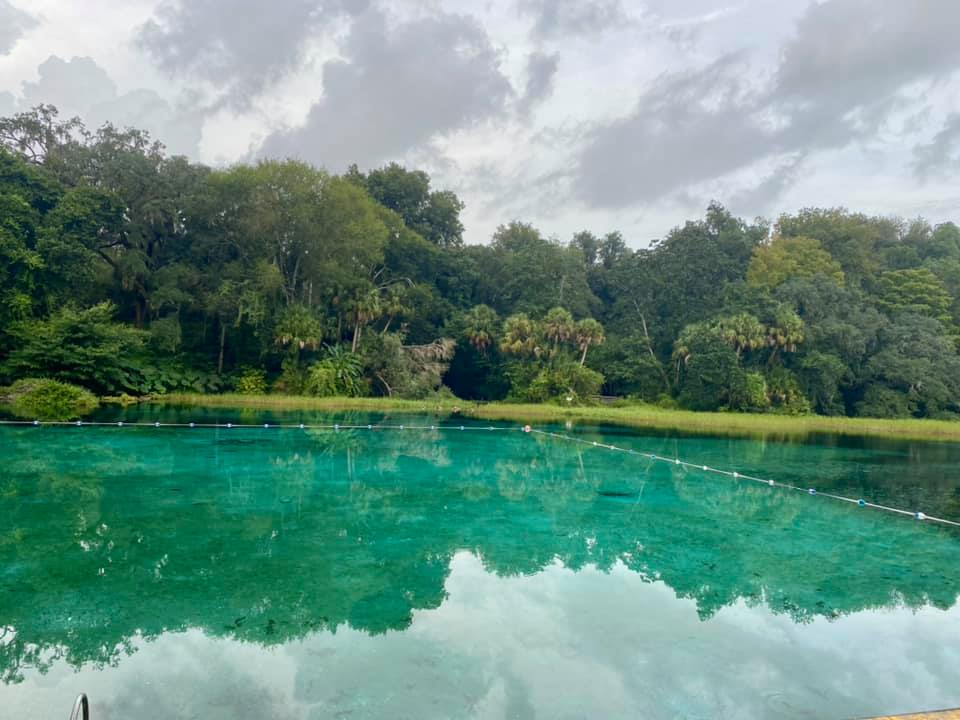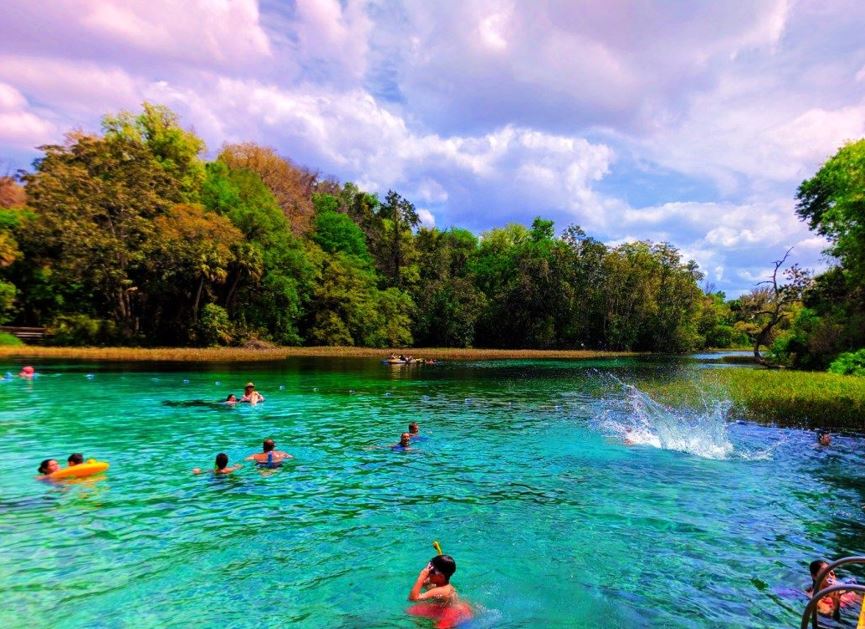The Rainbow Springs State Park is Florida’s 4th largest spring that churns out over 150 million gallons of water in a day. The springs at the park have been used by people for thousands of years, landmarking it as one of the historic and wondrous natural beauty. The park covers a massive area of 1,470 acres and has three main entrances: the head-springs(day-use area), the tubing facilities, and the campground.
The visitors at the Rainbow Springs State Park can swim in the crystal-clear water, tube down the peaceful Rainbow River, enjoy the scenic natural surrounding with friends and family, or stay the nights at the campground to enjoy the fresh air near the lushful spring.

History of Rainbow Springs State Park
The Rainbow Springs State Park has a rich history dating back to centuries ago when the native people visited the park for its lustful springs. The state park has served a significant role in sustaining animal and human lives for centuries. The sapphire-blue clear water at the Rainbow Springs State Park is the signature feature that tells the story of 10,000 years ago when the human first discovered the natural landmark.
At one time, even mastodon and mammoth fossils were found in the Rainbow River alongside the American Indians who used the river as a transportation means and for fishing. That shows how impactful was the presence of the prosperous spring.

In the later early 20th century, the surrounding area of the mark was used for mining phosphate; the new potential industry gave birth to the towns like Juliette and Dunnellon. Many natives living in the area depended on mining jobs, especially after the freezing temperature of the 1890s devastated the citrus industry. Phosphate mining also attracted a lot of people in the area looking for jobs after the thrive of the industry. The huge steam-powered machines left the pits during the mining later became the perfect location to build the waterfalls to turn the park into a tourist attraction. Juliette that shined and boomed in the mining era no longer exists; the town used to exist on the area that is now the park’s property.
During the 1930s, the Rainbow Springs State Park became a private theme park; waterfalls were built on the piles of the phosphate tailings, including a zoo rodeo with a collection of exotic animals, gift shops, leaf-shaped gondolas, and monorail were added in the private property. During the mid-20th century, the business owners capitalized on the tropical image of Florida to promote it as a natural oasis giving birth to the Golden Age of tourism in Florida, the 1960s.
However, the development of the interstate highway system in Florida eventually dried the business at the Rainbow Springs State Park as the interstate highway passed by the small towns that hosted similar newer and modern attractions. The attractions of the Orlando located in central Florida attracted the tourist to its modern, easily accessible charms, and by 1974, the privately-owned Rainbow Springs State Park was shut down.
Re-launching as the State Park’ in the 1990s, the residents of the area supported the park and formed the group ‘Friends of Rainbow Springs. The park support group dedicated itself to bring life back to the spring park by clearing the trails, taking care of the gardens and other necessities to remodel the state park as an attractive travel destination.
Now, as the result of the consistent dedication from the ‘ Friends of Rainbow Springs’ group, the Rainbow Springs State Park is one of the designated National Natural Landmark in Florida.
10 Things To Do At Rainbow Springs State Park
#1 Tubing
Tubing is one of the most popular things to do in the state park, the tubing on the beautiful Rainbow River. The natural river, surrounded by scenic greenery, offers the perfect opportunity just to kick back and relax in the peaceful environment. Visitors can rent the tubes within the park; the tubing isn’t allowed within the headsprings area of the park; the tubing part has been located on the Southwest of the Dunnellon, where the river has grade current for peaceful water adventure.

#2 Canoeing and Kayaking
For the visitors looking for a little more thrilling and exciting water adventure, the Rainbows Spring State Park also hosts canoeing and kayaking adventures. Visitors are allowed to launch their own private canoes and kayaks from the headspring launch area or rent it from the park. As the top recreational water sports destination in Florida, the state park offers one of the best thrilling water adventure locations; though there is no vehicle access to the river within the park, visitors have to port their vessels through the distance of 1,800 feet from the parking area to canoeing and kayaking launch area.

#3 Swimming
The cool and refreshing clear water from the headspring of the Rainbow Springs State Park is the perfect destination to escape the summer heat. The average depths in the swimming areas of the spring ranges from 5 to 18 feet, with the water temperature averaging 72 °F all around the year. Visitors are not allowed to bring rafts, tubes, and balls inside the park for safety reasons; however, the swimmers are allowed to wear lifesavers or use noodles if they cannot swim well. Besides the wading area for children, the depth of the river is over 5 feet deep, so the visitors are suggested to carefully monitor the children in non-swimmer as there are no lifeguards in the park.

#4 Snorkeling
Snorkeling in the headspring area of the Rainbow Springs State Park is visitor’s favorite activity, but the water adventure is only allowed in the buoyed swimming area. However, the visitors can still tag in the adventure outside the headsprings areas, from the campground, or using boats. The visitors are required to possess the dive flag by state law if they are looking for some underwater adventure inside the springs park.
#5 Hiking
The beautifully decorated gardens laced with azaleas, oaks, and magnolias, trails passing the three man-made waterfalls are just a few exemplary attractions for the hike enthusiasts inside the Rainbows Springs State Park. The peaceful, serene environment, chiming birds, and cruising rivers give the perfect sensation of going back to nature for hiking or just slowly strolling by the river banks. The state park has benches along its paths to provide resting opportunities to the visitors; the walkways are a mix of brick, concrete, and asphalt surfaces so visitors won’t have any troubles strolling around. Further, a nature trail winds through the natural oak hammock and sandhill communities. The trail approximately 2.5 miles long from the visitor center offers both Rainbow River and phosphate pit overlooks.
#6 Fishing
The fishing opportunity in the Rainbows Spring State Park may be the perfect deal for the people who are just looking for a quiet, peaceful day out. The state park allows fishing to the registered campers only, so the non-registered visitors cannot try out their luck in the river. Fishing is prohibited in the headspring day use areas as it is an aquatic preserve, but the registered campers are can go all out at the campground of the park.
#7 Wildlife Viewing
Throughout its areas, the Rainbow Springs State Park, on all the nature trails alongside the river, offers wonderful opportunities to witness the wildlife from up close. The state park itself is part of the Great Florida Birding and Wildlife Trail offering an outstanding birding area inside its premises. The commonly seen birdlife inside the park includes woodpeckers, wading birds, hawks, songbirds, and owls. The state park offers a brand new park birding list and guided bird walk on the second Saturday of every month except June to August.
#8 Geo-Seeking
The outdoor game played using GPS devices is a popular sport in Rainbow Springs State Park. It is an inexpensive, interactive, and high-tech treasure hunt game that offers a great opportunity to learn geography. The participants in the game use location coordinate to find the treasure. Sometimes the treasure hunt can be smooth as cake or difficult during some games. One of the biggest rewards in the geo-seeking game is that the players can discover a place where they have never been before.
#9 Picnicking
The Rainbow Springs State Park offers uncovered picnic tables and grills for the visitors to use on a first-come-first-serve basis; the visitors cannot pre-reserve the picnic spot and have to arrive early to get a space. The visitors are not allowed to move the picnic table, they are allowed to bring personal chairs, tables, and shade canopies inside the park for picnicking, but the tents on the picnic ground are prohibited. The picnickers have to carry their picnic items up the long entrance walkway and through the tollbooth to reach the picnic destination.
The state park also offers four pavilions at the headsprings, making it the best location for family reunions or gatherings.
#10 Camping
The Rainbow Springs State Park campground is located along the Rainbow River at a different facility a few miles away from the main headspring and day-use area. Offering a wonderful opportunity to get in touch with mother nature, the camping sites are equipped with water and electricity facilities. The maximum RV length in the park is 103 feet, the ADA-accessible restroom is available within the campgrounds, and a dump station is located between the upper and lower campgrounds. The campers are allowed to bring their pets to the campground, but they are not permitted in the swimming area and buildings.
Amenities
The Rainbow Springs State Park is committed to providing several amenities to all of the park’s visitors.
- Amphitheater: The amphitheaters are available to the registered campers for their own use.
- Campground store, showers, restrooms, and laundry.
- Lift chair for swimming in the spring.
- Visitor center
- Interpretive exhibits.
- Campsite with concrete pad, picnic tables, ground grill, and nearby restrooms.
- A pet-friendly park must be kept on a 6-foot leash all the time.
- Concession and restaurants.
Hours and Fees at the Rainbow Springs State Park
Headspring Charges: 8:00 am to sunset, all-around the year(unless closed at capacity)
$2 per person, children under the age of 6 are admitted free.
Tube & Tram Ticket: $20 per person, general 8:00 am to 3:30 pm operations.
Canoe and Kayak: 1-2 people one hour=$16 and whole day=$50
Three people max 1hours=$22 and whole day=$60






